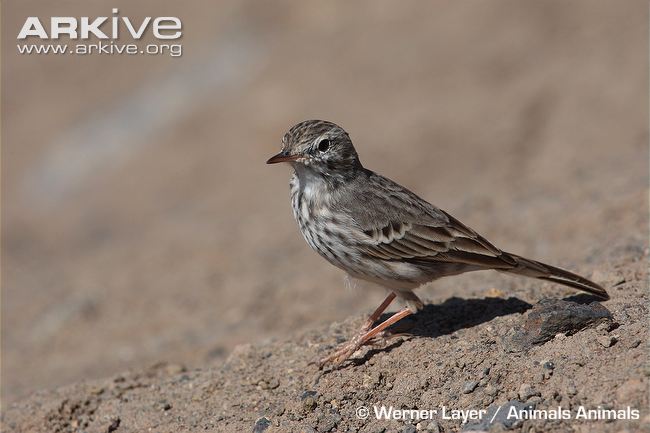
Anthus berthelotii
TAXONOMY
Anthus berthelotii Bolle, 1862, Canary Islands. Two subspecies.
OTHER COMMON NAMES
French: Pipit de Berthelot; German: Kanarenpieper; Spanish:
Bisbita caminero.
PHYSICAL CHARACTERISTICS
5.5 in (14 cm); 0.6 oz (16–17 g). Brownish-gray upperparts
with white brow stripe. Underparts buff-gray with dark streaks.
DISTRIBUTION
A. b. berthelotii: Canary Islands and Ilhas Selvagens; Anthus b.
madeirensis: Madeira.
HABITAT
Mostly island habitats; prefers dry, open areas (including rocky
plains and slopes) with bushes, grass, and herbaceous vegetation;
also open grasslands, cultivation, vine-clad slopes, dunes,
areas of volcanic rock, and open pine forests.
BEHAVIOR
Territorial, possibly throughout the year, but forms small groups
in winter. Often very tame. Runs rapidly; jumps nimbly over
boulders. Sedentary; not recorded outside island breeding range.
FEEDING ECOLOGY AND DIET
Eats insects and seeds. Forages on the ground, climbing over
small plants.
REPRODUCTIVE BIOLOGY
Monogamous; breeds January through August. Nest is a cup of
stems, lined hair, wool and feathers; on ground under low
plant, bushes or stone; female builds. Lays two to five eggs.
Possibly double-brooded.
CONSERVATION STATUS
Not threatened. Locally common throughout most islands
where it occurs, but has declined on Gran Canaria.
SIGNIFICANCE TO HUMANS
None known.
Photo Gallery of - Berthelot’s pipit




 Animalia Life
Animalia Life